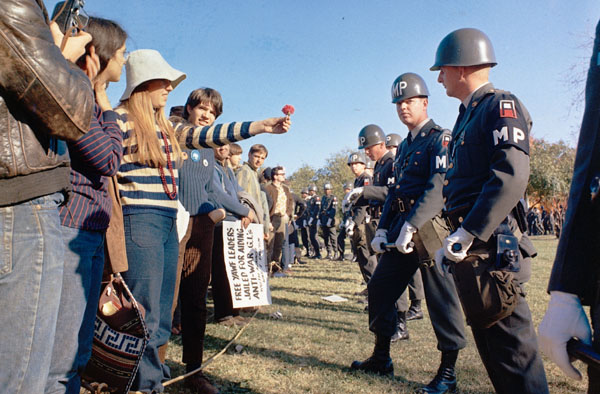Demonstrations against the war in Vietnam began even before the Gulf of Tonkin incident in 1964. By 1966, students were burning draft cards, and organized protests drew tens of thousands of people. A majority of Americans still supported the war, but as American casualties mounted, news of atrocities like the My Lai massacre became known, and victory seemed no nearer, protests grew larger. In 1970, when President Nixon announced that the U.S. would begin targeting supply lines and bases in Cambodia, college campuses exploded in protest.
Although the anti-war protests of the 1960s and 1970s are remembered today mainly as something young people participated in, people aged 18 to 29 actually were more likely to support the war than their elders, and college campuses were deeply divided on the issue. Protests in cities drew people of all ages and backgrounds. In 1966, a group of 100 veterans of previous wars tried to return their medals to the White House in protest of the war in Vietnam. Some protesters were pacifists who opposed all wars. Many believed that the United States had no business interfering in the internal affairs of other countries. Others were pushed to the anti-war movement by the failures of American policies.
In October 1967, some 100,000 people attended a demonstration at the Lincoln Memorial in Washington, D.C. At least 30,000, and perhaps 50,000, then marched to the Pentagon, where they remained all night and into the next day. Some demonstrators clashed with military police, and more than 600 were arrested. The newsreel above shows footage of the October 1967 protest. As you watch, consider the narrator's words, the images shown, and the music that accompanies the film.
- Based on the narrator's words, was the crowd mostly peaceful or mostly violent?
- According to the film, what percentage of demonstrators were arrested?
- Based on the images in the film, does the crowd appear to have been mostly peaceful or mostly violent? If you watched the film with the sound off, or were deaf, what impression would you have of the demonstration?
- How does the music make you feel?
- How do the impressions made by the images, narration, music differ from one another? Which is most powerful? How accurately do they seem to portray the event?
- How did the newsreels' creators intend viewers to think about the protesters?
